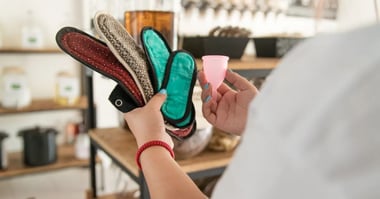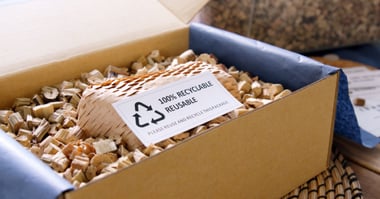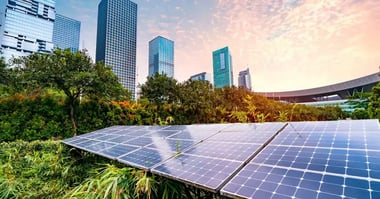
Maura Monaghan
Maura Monaghan has been a digital writer for five years now, covering everything from sustainable ecommerce to types of plastic. She's interested in ecommerce, sustainability, and the ways they can overlap. When she's not writing, she's probably out searching for the perfect cup of coffee.
Globally, we produce more than 380 million tons of plastic every year, and some reports indicate that up to 50% of that is for single-use purposes – meaning it’s only used once before getting thrown away.
The environmental impact of single-use plastic is undeniable, especially when you consider that it takes hundreds of years to decompose. But the good news is that there are plenty of greener alternatives to plastic out there, and businesses are in a unique position to drive the shift from single-use plastics to more eco-friendly materials.
Below, we’ll take a look at the best alternatives businesses can use in place of the harmful single-use plastic we’ve come to know.
What’s on this page?
01 | The top 7 alternatives to single-use plastic02 | Is biodegradable plastic sustainable?
03 | Mono-materials vs multi-layer materials
04 | Summary
05 | FAQs
The top 7 alternatives to single-use plastic
| No. | Material | Best for |
| 1 | Cloth | Retail shopping bags |
| 2 | Mushroom packaging | Differentiating your brand |
| 3 | Stainless steel | Food storage |
| 4 | Beeswax wraps | Replacing cling film |
| 5 | Bamboo | Investing in your reputation |
| 6 | Glass | Use in cafes and restaurants |
| 7 | Mono-material plastic | Phasing out single-use plastics |
* Each brand is different and will find that some alternatives are more suitable than others. It's a good idea to get a packaging assessment tailored to your brand to see where your business can cut back on plastic and whether any alternatives would shrink your carbon and plastic footprint.
1. Cloth
Best for: Retail shopping bags
From reusable bags for retail shopping to protective wraps for produce, chances are you’ve already seen cloth in action as a washable, sustainable alternative to plastic. And if you’re clued into the latest tote bag craze, then you know that this eco-friendly option can be quite fashionable, too.
Popular materials for cloth bags and wraps in the sustainable retail industry include cotton and hemp, both of which are completely biodegradable. Plus, if you custom-brand your cloth bags, they can serve as both an eco-friendly product and a marketing tool.
2. Mushroom packaging
Best for: Differentiating your brand
Mushrooms and other fungi are one of many natural resources that can be used as an alternative to plastic packaging (other unorthodox options are made from corn and even seaweed!).
This plastic alternative is made from mycelium, the root-like structure of fungal strands that transport nutrients. It’s more expensive to make than traditional cardboard, but because mycelium can be grown from waste materials, it creates a sort of closed-loop system that repurposes existing agricultural waste.
Mushroom packaging functions a lot like cardboard, except that it is completely compostable. Shouting about this unique material will definitely help you differentiate from the competition in your customers’ eyes!

3. Stainless steel
Best for: Food storage
Stainless steel is often used to create durable and reusable water bottles, straws (looking at you, paper-haters!), and food containers. It’s resistant to rust and can be easily cleaned, making it a great option for products with everyday use.
Stainless steel isn’t just a better option for the planet – it’s also better for your health than reusable plastic bottles and food containers. The unnatural chemicals in plastic can leak into water and food over time, and exposure to them is linked to health problems ranging from fertility issues to heart complications and cancer.
Stainless steel containers, on the other hand, don’t contain those harmful chemicals and therefore won’t leak them into your food and drinks, even if you fill them with hot liquids. And if you don’t manufacture food containers, you can still make the switch to stainless steel for the cutlery, plates, and drinkware in your offices as a way to elevate the employee experience.
4. Beeswax wraps
Best for: Replacing cling film
This one is a bit creative! A natural alternative to cling film or plastic wrap, these wraps are made from cotton infused with beeswax, resin, and jojoba oil. They can be molded around food or containers using the warmth of your hands, and they’re completely reusable.
When it does come time to throw them away, beeswax wraps break down naturally, making them much greener than their plastic film counterparts, which have a decomposition process that takes years and leaves damaging toxins behind.
If nothing else, this material is a cool thing to offer to your employees – it’ll be the talk of the table at lunchtime!
5. Bamboo
Best for investing in your reputation
Bamboo is a fast-growing renewable resource – in fact, some species can grow up to 1.5 inches per hour!
As an alternative to plastic, it’s used to make utensils, toothbrushes, and even clothing. It’s 100% biodegradable, and it doesn’t require any pesticides, fertilizers, or excess water in order to grow.
Transitioning from plastic to bamboo products may require more of an upfront cost for businesses, but your customers will be happy to see the switch: using bamboo can help reduce your company’s carbon footprint because it absorbs more carbon dioxide than trees as it grows. That’s an important distinction in a world where more than 60% of people are basing their purchase behaviors on sustainability and ethical criteria.
7. Glass
Best for: Use in cafes and restaurants
This list wouldn’t be complete without the classics. Recyclable and long-lasting, glass is a popular plastic alternative for bottles, food storage containers, and jars. Similar to stainless steel, glass doesn’t leak chemicals into food or drinks, ensuring a healthier consumption experience than you’d get with single-use plastics.
Cafes and restaurants can use glass jars and bottles for serving drinks and storing food. Retailers can offer glass containers for bulk items and promote reusable glass packaging. Plus, encouraging customers to return glass bottles for a deposit or a discount can also help boost their use among customers. In the UK alone, 58% of survey respondents said they’d be “very likely” to use a bottle deposit scheme.

8. Mono-material plastic
Best for: phasing out single-use plastics
A “mono-material” is a product composed of a single material or fiber, rather than a combination of multiple materials. Mono materials are more easily recycled, because they don’t require any energy to split or separate various materials.
For example, some brands will switch to cardboard because it has a smaller carbon footprint than plastic in some cases. But since paper and cardboard can’t hold liquid — we’re looking at you, mushy paper straws — brands will have to add a plastic lining inside these products.
Not only does this mislead customers into thinking the product is more environmentally friendly than it is, but it also makes it incredibly hard to recycle this product now, given there are two different types of materials.
More easily recycled means more easily reintroduced into the economy without having to extract new resources, which makes mono-material plastic a more sustainable alternative to single-use plastics.
Is biodegradable plastic sustainable?
Biodegradable plastic is a type of plastic designed to decompose naturally through the action of living organisms, such as bacteria, fungi or algae. Unlike traditional plastics, which can linger in the environment for hundreds of years, biodegradable plastics break down more quickly into natural substances like water, carbon dioxide, and biomass.
However, the sustainability of biodegradable plastics is a complex issue. On one hand, they offer the potential to reduce the accumulation of plastic waste in the environment, especially in landfills and oceans. However, if biodegradable plastics aren’t managed properly once thrown away, then they won’t break down as intended.
Biodegradable plastic is lab-tested to ensure it breaks down under controlled conditions. But in nature, most variables can’t be controlled, meaning it can’t be guaranteed that this material will break down properly in real life.
Mono-materials vs multi-layer materials
While mono-materials are easier to recycle because they don’t need to be separated into different components, multi-layer materials are made of different materials that are bonded together. This makes recycling challenging because the different materials must be separated before recycling, which is difficult and not always possible.
Because of this, multi-layer materials are less likely to be recycled and more likely to end up in landfills. Some common products made of these multi-layer materials are beverage cartons and laminated food packaging.
Summary
Single-use plastic is a huge presence in the supply chains of most businesses, and it’s a real problem for the future of our planet. But there are plenty of plastic alternatives out there to consider if you’re looking to be part of the change.
Want to reduce your business’s plastic footprint? We can help. All you have to do is get in touch with our in-house team. Once we’ve received your details, we can arrange a call to discuss which plastic recovery plan will suit your business needs best.
FAQs
What can we use instead of plastic?
There is a whole host of plastic alternatives out there for businesses to make use of in order to make their supply chain more eco-friendly. Different materials suit different purposes best, whether it’s cloth for reusable bags or stainless steel for food containers.
What will replace plastic in the future?
That one’s up to us! We all have a part to play in creating a future without single-use plastic, but its replacements can look different for different businesses. You don’t have to choose just one plastic alternative, either – depending on the products you sell, multiple options can fit within your business model.
Is there a biodegradable alternative to plastic?
Biodegradable plastic exists, and is often made from renewable resources like corn starch or sugarcane. It has the potential to be a sustainable plastic alternative, but the conditions in which it will actually break down properly are hard to control, so it’s not the super-solution that it’s often made out to be.

.webp)
.webp?width=380&name=ESG-presentation%20(1).webp)

.webp?width=380&name=Sustainable%20christmas%20(1).webp)
.webp?width=380&name=Buying-online%20(1).webp)


.webp?width=380&name=Sales%20(1).webp)

.webp?width=380&name=Sorting-trash%20(1).webp)
.webp?width=380&name=Shopping%20for%20sustainable%20beauty%20products%20(1).webp)
